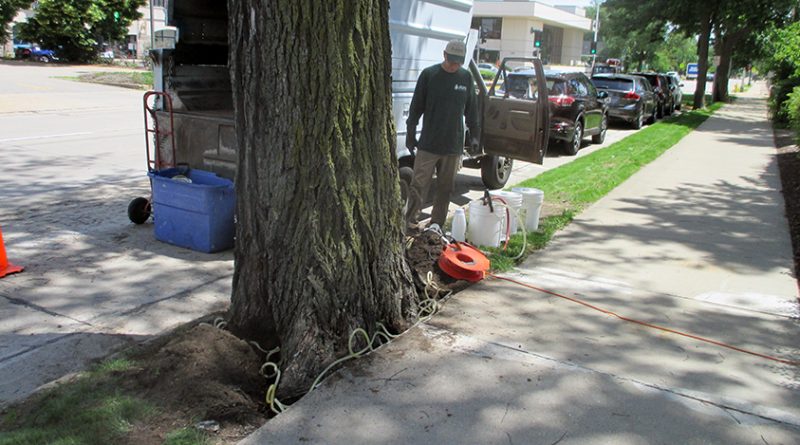Column: Dutch Elm Disease preventable
Dutch elm disease—Ophiostoma ulmi—season has begun its annual reign of mortality on American elms, but if residents know what to look for and the disease is caught early, elm trees can be saved.
This disease is largely preventable if the elm trees are injected with a fungicide applied by a certified arborist.
Dutch elm disease is spread overland by two types of beetles that feed in the crotches of young twigs of elms. The beetles carry a fungus that causes the disease on their bodies, and the disease is introduced to the tree as the beetles feed. The fungus then plugs the vascular system that transports water throughout the tree, the leaves turn yellow, and the tree eventually dies.
The yellowing of the leaves is called “flagging” and usually shows up in the upper crown of the tree first. Once you notice “flagging” in your elm tree it is important to act fast. If you notice a yellowing branch in your elm tree, primarily in June, July, and August, notify the Stevens Point Forestry department or call a tree care company to take a look at the tree.
If noticed early, it is possible to save the tree by pruning out the infected branches and/or injecting the tree with a registered fungicide. If nothing is done, the disease won’t go away, and the tree will surely die.
Elms can also be injected with the same fungicide as a preventive measure that is usually good for three years.
If an elm has been determined to have DED and cannot be saved, it must be condemned. The forestry department will mark the elm with an orange dot and notify the landowner that they must remove the tree quickly because removing diseased elms limits the breeding sites of the beetles that are attracted to the infected trees and spread the disease.
Removing diseased trees quickly may also prevent root graft spread of the disease to neighboring elms. To prevent root graft spread of DED, it is best to cut the roots between a diseased tree and a healthy tree to a depth of at least three feet, and then remove the diseased tree.
A tree care professional should be contacted for this because it is important to place the trench to cut the roots in the right place and to make sure the remaining tree has a sufficient root system for stability. Diggers Hotline should also be contacted before such work takes place.
During the 1960s and 1970s, Stevens Point, like most Midwestern cities, had its American elm trees nearly wiped out by Dutch elm disease. The city took an aggressive approach to the problem and implemented a strict sanitation program to try and control the effects of the disease. This sanitation program is still in effect today, and as a result, Stevens Point still has a fair number of large American elms left.
If residents know what to look for, remove and/or prune their diseased elms in a timely fashion, and keep the remaining elms healthy, Stevens Point should be able to continue to enjoy the beauty of the American Elm.
For information on injecting your elm to prevent your tree from getting DED, contact the Stevens Point forestry department, or contact your tree care professional.
City Forester Todd Ernster can be reached at (715) 346-1532.


